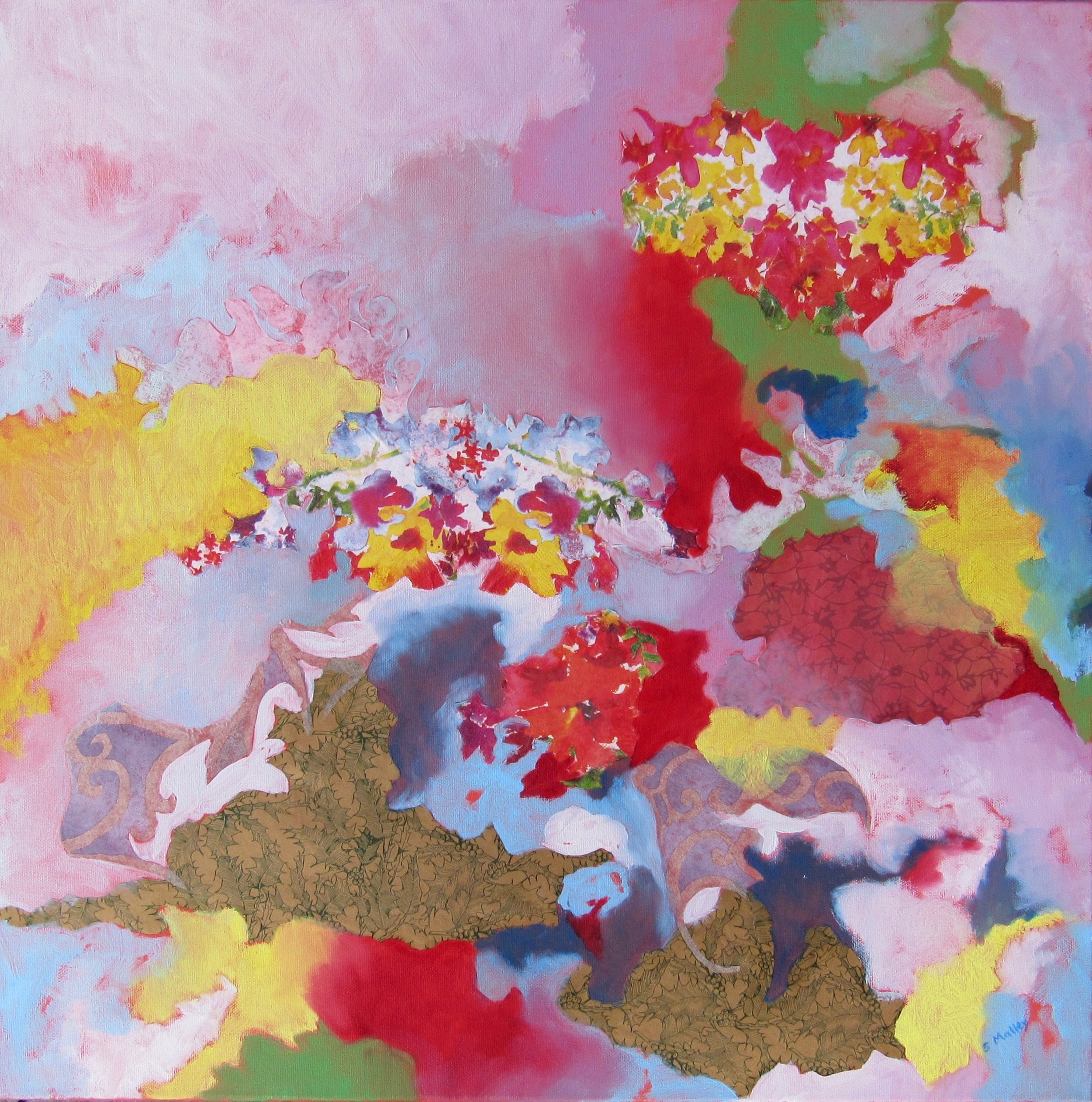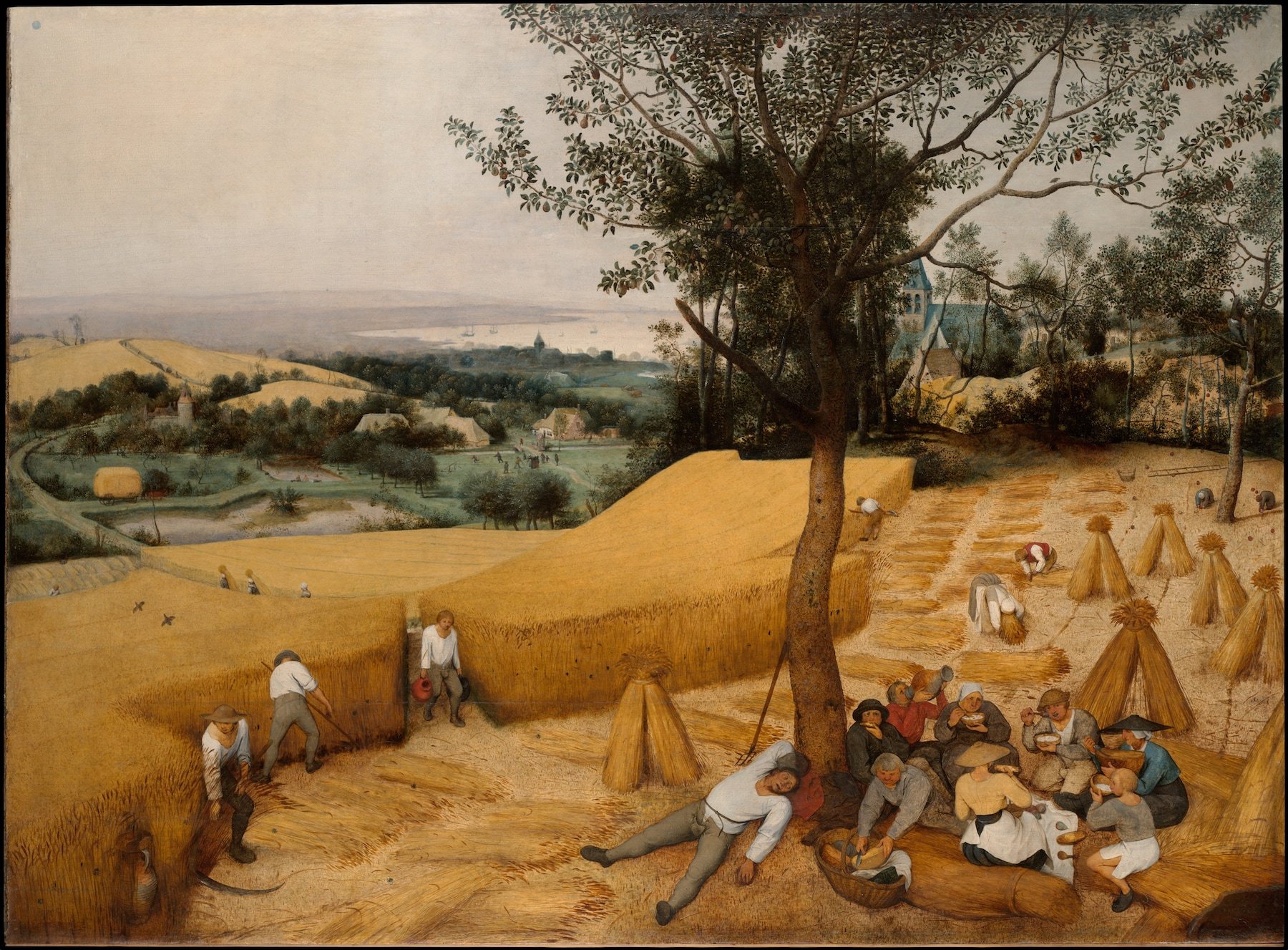By Alicia Perkovich, Gallery Assistant Intern & Heat Exhibition Specialist
Sharon Malley, Mindscape I, 2021
Sharon Malley created her piece for the July member show in December. The work, Mindscape I, is a collage of vibrant warm tones— where blooming floral shapes cover a background of lilac tones. Commenting on her work, Malley writes that it “was to be the underpainting for an abstract image in pastel colors, focused on winter weather. However, as I worked on it, I realized it was expressing my desire to ‘get on’ with winter, as I prefer warmer months.” And so, through her hot colors, Malley not only visualizes her desire for summer, but the heat of summer itself.
In a collection of blog posts throughout this month, we’ll be guiding you through numerous manifestations of heat in art— from both our Touchstone member artists and the art historical cannon. This post will outline various ways artists have visualized heat, and how in historical and contemporary contexts heat can stand as an allegory for concerns of life and death.
An allegorical representation of heat— meaning that heat is supposed to represent an immaterial idea, often with political, religious, or social significance— was common throughout the Renaissance. In the Northern Renaissance, which was centered in the 15th and 16th century Netherlandish region, depictions of summer bounties represented the benefits of hard work. We can see this best in Peter Breugel the Elder’s The Harvesters. This painting shows peasants laboring in various steps of the wheat harvest, as well as a group of people in the background enjoying the leisure that awaits the peasants after completing the harvest. Both a landscape of Netherlandish summer and an ethnographic depiction of peasant behaviors, Breugel is showing how heat is a time of bounty, but only after a period of hard work. Nature’s cycle of harvest comes to represent the human cycle of labor and leisure and that hard work must be obeyed in order to come to a period of relaxation.
Peter Breugel the Elder, The Harvesters, 1565
Artists of the same time also depicted heat in the fires of hell, as posthumous punishment for a life of sin and folly. Of the same time as Bruegel, painter Hieronymous Bosch often used heat as a religious allegory. Bosch used both common proverbs and biblical texts to criticize sinful actions, and warn of the damnation in Hell that awaits sinners. For example, in The Triptych of Saint Anthony, a fiery inferno becomes the setting to host demons and sinners which tempt the most holy saint into committing acts of sin. In The Haywain Triptych, a group of foolish people who live lives of sin are carried in a giant hay cart— representing the world’s superficial material goods— from the center panel into the right panel, which depicts a fiery Hell.
Hieronymus Bosch, The Haywain Triptych, 1512-1515
In our show, member artists also have visualized heat in ways that evoke life and death, but from secular aspects. Placed next to each other, Maureen Squire’s Nebula Series XII, The Butterfly Nebula and Steve Wanna’s Myths of Creation - CE191111.1914 show us moments of space’s heat. Wanna’s work is part of an ongoing series that relates the cosmic life cycle to the human inclination to origin myths. Based on space photography, Wanna splatters paint to capture the energy of a singular moment of creation. In space, a supernova explosion that inspires this work can reach temperatures of 1 billion degrees Celsius, while a nebula’s cloud of dust can peak at 10,000 degrees Celsius. Squire’s red nebula, ejecting itself against the black background, is ignited in its own heat, but we can see how its materials will dissipate into the cold universe (which averages at -455 Farenheit). While on its surface these three works may just depict moments of space activity, they all use heat as an entrypoint to discuss birth and death— whether it be secular myths of creation, the beauty in a star’s death, or looking back on an optimistic time of expansion that has gone. By visualizing heat, these artists also visualize key changes in life.
Steve Wanna, CE191111.1914, 2019
Continuing with our gallery, we can see the visualization of heat clearly in Amy Sabrin’s Reflections on the Shower Glass (or Self-Portrait with I-pad). This watercolor shows Sabrin in an orange shirt, taking a photo of herself from the glass door of a shower, with its handle and faucet visible. Atop the self-portrait are curved white lines on the shower’s glass, evoking heat waves in the condensation and steam resulting from a shower.
Left: Amy Sabin, Reflections on the Shower Glass (of Self-Portrait with iPad); Right: Maureen Squires, Nebula Series XII, The Butterfly Nebula, 2022
If you’re interested in a focus on surfaces, and the effect of heat and light on them, exploring the photorealism movement would be of interest. Photorealism, an American art movement during the late 1960s and early 1970s, characterizes oil paintings that attempt to replicate photographs. A meticulous process, photorealism treated subjects as a surface to replicate, painting things out of focus or blurry if they were photographed as so, but also honoring how light reflects off of surfaces, how heat may cause surfaces to distort. This is something we see clearly in Ralph Goings’ paintings of diners and other relics of the Americana lifestyle.
While heat itself doesn’t have a specific form or shape, we can see it through bright colors, manipulations of light, and explosions of action. Isolating the transitory sensation of heat allows artists to use the implications of that moment to relish in its temporary nature, and comment on ideas that are similarly fleeting. Look out for our upcoming blog posts to learn about other ways that artists depict heat!
Ralph Goings, Ralph’s Diner, 1981-1982






